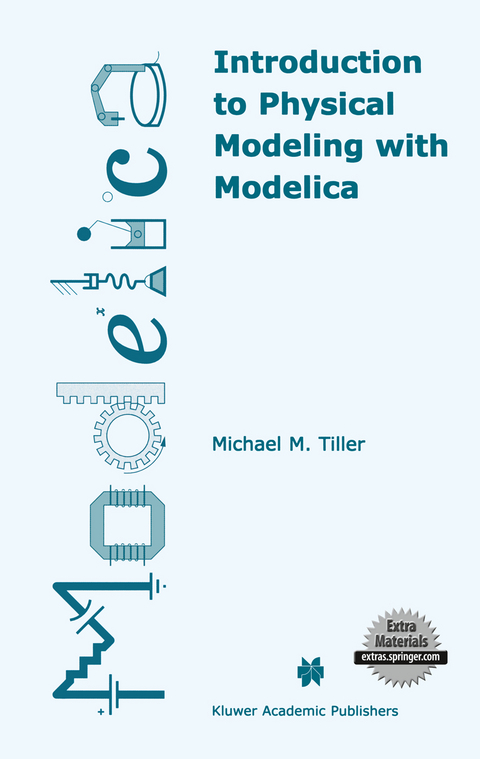
Introduction to Physical Modeling with Modelica
Springer (Verlag)
978-0-7923-7367-4 (ISBN)
3. 8 Problems . . . 66 4 ENABLING REUSE 69 4. 1 Concepts . . . . . . . . 69 4. 2 Exploiting commonality 70 4. 3 Reusable building blocks 71 4. 4 Allowing replaceable components 75 4. 5 Other replaceable entities 79 4. 6 Limiting flexibility . . . 82 4. 7 Other considerations . . 84 4. 8 Language fundamentals 85 4. 9 Problems . . . . . . . . 88 5 FUNCTIONS 91 5. 1 Concepts . . . . . . . . 91 5. 2 Introduction to functions 92 5. 3 An interpolation function 94 5. 4 Multiple return values 96 97 5. 5 Passing records as arguments 5. 6 Using extemal subroutines 100 5. 7 Language fundamentals 102 5. 8 Problems . . . . . . . . 110 6 USING ARRAYS 113 6. 1 Concepts . . . . . . . . . . . . . . . . . . 113 6. 2 Planetary motion: Arrays of components . . 113 6. 3 Simple ID heat transfer: Arrays of variables 120 6. 4 Using arrays with chemical systems 132 6. 5 Language fundamentals 143 6. 6 Problems . . . . . . . . . . . . . . 152 7 HYBRID MODELS 155 7. 1 Concepts . . . . . . . . 155 7. 2 Modeling digital circuits 155 7. 3 Bouncing ball . . . . . . 162 7. 4 Sensor modeling . . . . 166 7. 5 Language fundamentals 178 7. 6 Problems . . . . . . . . 186 8 EXPLORING NONLINEAR BEHAVIOR 189 8. 1 Concepts . . . 189 8. 2 An ideal diode 189 8. 3 Backlash . . . 193 8. 4 Thermal properties 199 Contents vii 8. 5 Hodgkin-Huxley nerve cell models 203 8. 6 Language fundamentals 206 8. 7 Problems . . . . . . . . . . . . . . 210 9 MISCELLANEOUS 213 9. 1 Lookup rules 213 9. 2 Annotations . . 225 Part II Effective Modelica 10 MULTI-DOMAIN MODELING 231 10. 1 Concepts . . . . . . . . . 231 231 10. 2 Conveyor system . . . . .
I The Modelica Language.- 1 Introduction.- 2 Differential Equations.- 3 Building and Connecting Components.- 4 Enabling Reuse.- 5 Functions.- 6 Using Arrays.- 7 Hybrid Models.- 8 Exploring Nonlinear Behavior.- 9 Miscellaneous.- II Effective Modelica.- 10 Multi-Domain Modeling.- 11 Block Diagrams vs. Acausal Modeling.- 12 Building Libraries.- 13 Initial Conditions.- 14 Efficiency.- Appendices.- A— History of Modelica.- A.1 Contributors to the Modelica language.- A.2 Contributors to the Modelica Standard Library.- B— Modelica Syntax.- C— Modelica Standard Library: Connectors.- C.1 Electrical (Analog).- C.2 Block diagrams.- C.3 Translational motion.- C.4 Rotational motion.- D— Modelica Standard Library: Common Units.- D.1 Time and space.- D.2 Periodic phenomenon.- D.3 Mechanics.- D.4 Thermodynamics.- D.5 Electricity.- D.6 Physical chemistry.- E— Modelica Standard Library: Constants.- F— Modelica Standard Library: Math Functions.- F.1 Geometric functions.- F.2 Inverse geometric functions.-F.3 Hyperbolic geometric functions.- F.4 Exponential functions.- References.
| Erscheint lt. Verlag | 31.5.2001 |
|---|---|
| Reihe/Serie | The Springer International Series in Engineering and Computer Science ; 615 |
| Zusatzinfo | XXII, 345 p. With online files/update. |
| Verlagsort | Dordrecht |
| Sprache | englisch |
| Maße | 155 x 235 mm |
| Themenwelt | Informatik ► Grafik / Design ► Digitale Bildverarbeitung |
| Informatik ► Theorie / Studium ► Compilerbau | |
| Mathematik / Informatik ► Mathematik ► Angewandte Mathematik | |
| Technik ► Maschinenbau | |
| ISBN-10 | 0-7923-7367-7 / 0792373677 |
| ISBN-13 | 978-0-7923-7367-4 / 9780792373674 |
| Zustand | Neuware |
| Informationen gemäß Produktsicherheitsverordnung (GPSR) | |
| Haben Sie eine Frage zum Produkt? |
aus dem Bereich


